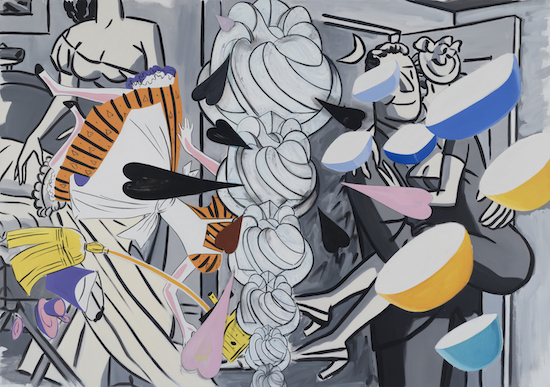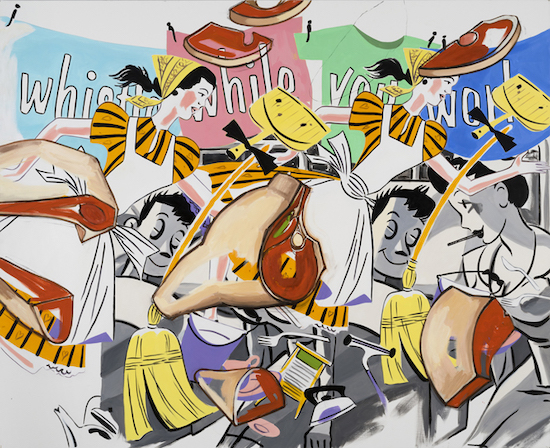David Salle, Autumn Rhythm (2018), oil and acrylic on linen © David Salle/VAGA at ARS, NY and DACS, London 2019. Courtesy of the artist and Skarstedt, New York
“They have a tempo, right?” David Salle says to me of the paintings on the walls of the gallery we’re walking through. Musicality and Humour, Salle’s present show at London’s Skarstedt Gallery, features around a dozen new canvases, each one well over a metre square. They have a frenetic energy to them, bustling with activities. Layers of bright colourful imagery juxtaposed with simple black-and-white line drawings in a way that is by turns playful and composed. Here and there, the brush strokes reveal themselves in a hurried thinning or apparently careless drip. But don’t let that deceive you. “The tempo of the painting is not a product of the speed of the execution,” Salle insists to me. “I mean, there’s clearly a relationship between how something is made and how it looks. You can’t tease them apart. But the sense of tempo in the paintings is more constructed.”
David Salle is not an “immediate” painter. For all the toon town bustle and slapstick humour in the works, they form and their sweep is structured as carefully as a symphony by Stravinsky (a composer, Salle confesses to me his admiration for). Unpicking the combinations of elements, their contrast and counterpoint, proves just as rewarding. “There is a lot of different ways to separate artists into category A and category B,” Salle says to me. “One way would be to say that an artist is an immediate painter, like someone who paints a scene or a shape in one sitting, and then a process artist, someone for whom the work evolves over time according to some sort of process – whatever the process is. I’m obviously the latter. So you feel different tempos of execution in different areas of the painting.” The eye, moving across the canvas, taking in layers of complexity, feels itself directed likewise.
Salle was born in Oklahoma in 1952, the same year – as the Scottish novelist Andrew O’Hagan points out during his Q&A with the artist in the gallery – that William Shawn took over as editor of the New Yorker magazine. Noted for his shyness and fear of elevators, Shawn was magazine founder Harold Ross’s ideas man before he took the top job and is credited with being as much responsible for the overall shape of the magazine as it is today as anyone: its scrupulous fact-checking, its air of urbane sophistication, the dry wit of its cartoons. This is the world Salle’s new paintings plunge you into. Many of their b/w lines are enlarged reproductions of old newspaper cartoons from the 50s. Its iconography of blood red steaks, broom sticks and coffee cups – sprayed across the canvas like so many stuttering cursors – recall those Hanna Barbera cartoons, The Jetsons and The Flintstones which successfully made eternal verities out of a particular image of American suburban domesticity at the very moment it was starting to disappear.
“I certainly wasn’t aware of the New Yorker,” Salle says to O’Hagan of his childhood reading habits, “but the magazine that occupied the place that the New Yorker would occupy later on was MAD magazine.” It was MAD, with its gross-out humour and irreverent mien, that gave Salle his taste for the comic, his long-standing interest in “humour as itself, on its own terms.”
And there is comedy here, too, in the faces of these bequiffed salarymen and their pinafore-wearing wives. But it is a humour frustrated, a humour with the punchlines removed, the captions taken away, and somehow all the funnier – and all the more musical – for this frustration of expectations.

David Salle, Grey Honeymoon (2018–19), oil and acrylic on linen © David Salle/VAGA at ARS, NY and DACS, London 2019. Courtesy of the artist and Skarstedt, New York
In person, Salle gives off a little of that New Yorker air of cool sophistication himself. He is softly spoken, well turned out, a little wry. His eyes narrow and face sharp. He is prone to a practised modesty. Many of his best gags are at his own expense – like, when he tells O’Hagan that he had previously “eschewed” black outlines since they seemed “like a crutch. But at a certain point," he continues wryly, "– a certain age – I’ll take any crutch I can get.”
There’s a sense of the artist having fun with himself in the works themselves. They’re playful in an obvious, thematic way, in the things they depict and they way they force abrupt collisions. But in subtler, more formal ways too. When I ask him about the central dividers that make several of these canvases seem like diptychs – the cascade of meringues that split the frame vertically in Grey Honeymoon (2018-19), the striped rocket-like shape that barrels through the middle of S.P. Divide (2018–19) – he describes it to me as “a dare to myself. One of the conventions of design is not to split things down the middle,” he says with sly half-smile, “so I wanted to do it anyway.”
“Like most kids, I drew,” is how Salle narrates to me his early entrance to the world of art. “I was encouraged in that<” he says,”the idea that was something one could do took hold pretty early. I was very fortunate in my town there was a private art school that was a very serious place with very serious people teaching. I started going there when I was really young.”
Like his friend and contemporary Eric Fischl, Salle spent much of the early 70s at Cal Arts, where he was taught by American conceptual artist John Baldessari. In his (2016) book, How to See, Salle says of his former mentor that “meeting him redirected my trajectory as an artist.” This, even if Baldessari’s famous “post-studio practice” course seems, on reflection, almost like a detour. “I was a painter before going off to Cal Arts,” Salle tells me today, “and then the five years I spent at Cal Arts – four of which I didn’t do any painting at all – I think of as almost a holiday or a sabbatical. A four year sabbatical. Then I left California and moved to New York, the painting part of my DNA just started to reassert itself.” A necessary detour, perhaps. “There were all these other interesting things you could do. But I’m not sure how seriously I ever took them.”
Today, Salle’s unique style is immediately recognisable and his work is widely exhibited, held in major public collections on (at least) three continents. The complex interplay of lines and colours that characterise his work is now “second nature,” he says. "I know without having to think about it that certain visual trajectories in the painting intersect and those intersections make energised episodes in the paintings." Still, paint, as he says to O’Hagan, “is not something one can ever take for granted. It can be very recalcitrant.” It’s in the way the work itself reveals that recalcitrance, the way the materials, the colours, the tumble of lines and images and trajectories can stop the idea or stymie the reflexes, that much of Salle’s magic resides.
Looking up at one of canvases on the wall, with its colourful exhortation to "whistle while you work", I find myself asking Salle if he himself ever whistles while he works.
"I don’t have to."
Perhaps the whistling is the work.
David Salle, Musicality and Humour, is at Skarstedt Gallery, London, until 26 April


